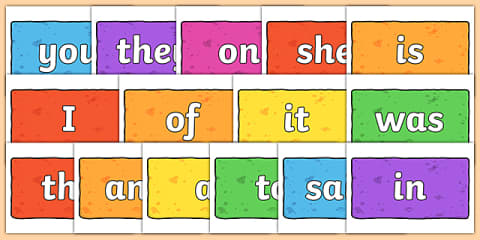High Frequency Words
High Frequency Words
High frequency words are those which appear most often in written English. Many high frequency words are also common exception words, such as ‘I’, ‘the’, and ‘you’What are high frequency words?
High frequency words are one of the main types of sight words and are those words which occur most frequently in written material, for example, "and", "the", "as" and "it". They are often words that have little meaning on their own, but they docontribute significantly to the meaning of a sentence as a whole.
Some of the high frequency words can be sounded out using basic phonic rules, for example, "it" is an easy word to read using phonics. However, many of the high frequency words are not phonically regular and are therefore hard to read in the early stages.
Some high frequency words are called tricky words, or sight words. In addition to being difficult to sound out, most of these high frequency words have a rather abstract meaning which is hard to explain to children. It's easy to learn words like "cat" and "house" because they can easily be related to a real object or a picture, but representing the words "the" or "of" is tricky because there's no point of reference.
Why are high frequency words important?
High frequency words are, as you'd expect, words that you come across frequently. This means that when children are reading, they'll see lots of these high frequency words. Therefore, it's important that children are able to read these words, pronounce them correctly, spell them, and understand what they mean within a sentence. Just as importantly, children will be using these words in their own writing, so it's an essential part of their literacy development.
Did you know that there are 16 words which make up around a quarter of every piece of writing, for both adults and children? These are examples of high frequency words, which shows exactly why it's essential for children to become familiar with them. Words such as 'he' 'and' 'I' and more tricky words such as 'you' 'said' and 'she' are everywhere when we write and read. As a literate adult, you might not notice them, but they can be significant hurdles for children when it comes to literacy if they aren't taught how to read and write them properly.
Recognising and being able to read high frequency words gives children more confidence.If a child can already recognise a quarter of the words in a text, they are more likely to want to keep reading. Being able to read and recognise these words can begin to make reading and writing less daunting to children during the early stages of their educational journey.
What are the top 100 high frequency words in order?
These are the top 100 high frequency words that are most frequently used in any piece of writing:the, and, a, to, said, in, he, I, of, it, was, you, they, on, she, is, for, at, his, but, that, with, all, we, can, are, up, had, my, her, what, there, out, this, have, went, be, like, some, so, not, then, were, go, little, as, no, mum, one, them, do, me, down, dad, big, when, it's, see, looked, very, look, don't, come, will, into, back, from, children, him, Mr, get, just, now, came, oh, about, got, their, people, your, put, could, house, old, too, by, day, made, time, I'm, if, help, Mrs, called, here, off, asked, saw, make, an.
How to teach children high frequency words
High frequency words, and phonics as a whole, are an essential part of a child's primary education. They form the basis for reading and writing, so it's important to teach them effectively. Here are a few tools that you can use to teach them:
- Flashcardsare by far the most popular way to teach this topic. You can cut them out and use them for a variety of games and activities which focus on repetition and boosting pupils' memory of high frequency words.
- Dictation passages are a great way to assess reading skills and knowledge of high frequency words at the same time. Children are given a piece of text with the high frequency words missing, and they must fill in the blanks. Through an activity like this, they'll become more familiar with the words themselves and develop their reading fluency.
- Look, say, cover, write is another common method that's used. Children practise saying the words out loud as well as writing and spelling them correctly. This is effective for memorisation of the sounds and spellings of the words and word recognition.
How can children practise using high frequency words?
Teaching children high frequency words in the first place is just one part of the process. To completely consolidate their learning, children need practise.
- One of the most common ways for children to practice high frequency words is by using a word mat. These list out a number of the high frequency words that children should know, usually 100 or 200. Children can keep them on hand when they're writing or reading, and they're also a brilliant visual and revision tool if they're displayed in the classroom.
- Another way is to use a word search. While children are searching for the words, they'll develop stronger word recognition skills and also learn how to spell the high frequency words. A word search is a fantastic revision tool and also simply a fun way for children to practise this essential part of their learning.



